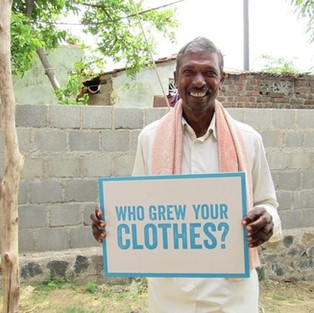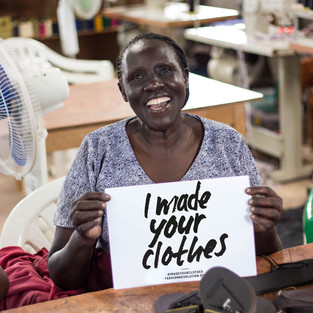The Fortune-telling of a Pair of Jeans
- Ebru Debbağ

- Apr 25, 2021
- 5 min read
Most of us have more than a pair of jeans in our wardrobes; right? and yet might know little about the making of jeans as well as the link to the climate, social, cultural, wealth injustice they have. Of course the decoupling of our material assets and the life expands beyond the jeans we own and yet could provide the ground for some food for thought as well as building on the idea of the interconnections that I have been dwelling on. The very idea of interbeing and the possibility of the understanding of our interbeing by a higher number of people, will accelerate the changes that we would like to see for a better life now and in the future.

It is estimated that 450million pairs of jeans are sold in the US every year. The global denim retail business has expanded worldwide to become 105 billion usd in 2019 ( Statista) and the average consumer owns 6 pairs ( 2019 Cotton Incorporated). This is a powerful industry as well as a powerful consumption segment which expands from the past to the future with global manufacturing and consumer use. I have fallen in love with denim and jeans as a teenager and have spent 3 decades and counting in the industry and I truly believe that the problems that are representative in denim and jeans also bear the beauty of the solutions to the problems. I will try to build on the idea of defining and attributing value versus cost and hopefully, maybe evoke some questions, a desire to redefine perceptions and behaviour.
To the untrained eye a pair of jeans might be simply a fashion item or you might have a passion for jeans but still not know the complicated design and manufacturing process in the background as well as the ecosystems and human labour behind the scenes. I thought that I might disclose the insider stories of denim and jeans as these untold stories have led us here. Here are some facts that I would like to share from my personal field experience of how denim and jeans came to be and might give some light into the future and how fast that future will reveal itself.
In the late 1990's the denim fabrics were almost all made out of mono fibers, mainly cotton and when elastane was initially introduced (and it was a pair of Fiorucci jeans for me) the whole industry went into a full revolt. My pair of Fiorucci's were bulky and almost heavy on my skin - not like the 2nd skin feel of stretch denim we have in the market now. Back then to the denim-heads stretch in jeans was as if jeans were being insulted. I was working in the sales and marketing of one of the leading denim mills and could see that jeans with elastane were the future as they were defined by a new consumer behaviour and life-style. Well - the production teams as well as the product development teams resisted and we were even introduced to a max of %15 as “stretch denim” sales policy - but as you might imagine not for too long. The market not only expanded into more stretchy fabrics but bi-stretches that defined further performance as well as an introduction of jeans into sportswear. Back in the early 2000's it was considered that stretch jeans were an item for the women's market and that verdict was to be overthrown a few years later as mens market initially started using what is referred to as comfort stretch to the expansion of skinny fits with super stretch over the period of 5 years. This happened because the way we live changed - urbanization demanded ease of movement, lifestyle changes enabled skinny jeans to become a night out dress code, denim was on the move and it had a smart dress code.

Something else happened during this period that changed the destiny of the denim and jeans industry - fast fashion got interested in denim. In fact just a few seasons before that by the 1990's was when the luxury brands started adding denim to their collections which was what triggered the denim on catwalks rolling out to be the staple items on the high-street. The fast fashion was based on offering what the luxury brands designed right off the catwalk and the new business model depended on speed and low cost. The value definition as we know did not exist in the formula , new materials, cheaper labour were needed to reduce cost of the items made.

The use of polyester yarns emerged as cheaper and higher performance requirements became prominent - the feel of polyester yarns were not appealing to all so a new technology needed to be “discovered” where the polyester was kept at the core of the yarn and cotton was wrapped around to provide a better feel on the skin. Many other versions emerged - jeans came to be a blend of polyester and cotton. Fast forward to today we are striving to transform the industry to become circular and are struggling to separate polyester from cotton in recycling. Start-ups, machine developers are working on chemical recycling, mechanical recycling techniques to enable the decoupling of natural material from the synthetic to enable recycling. All this happened within the last 20 years and we are still using more polyester in our jeans. I hope I am able to give you a birds eye view of how we have created the problem only to resolve it and as the inventors of this problem we are struggling to assign the solution. This is where we need a shift; a bolder move to shift what is not working to what may work. Can we see these series of events that have happened over a period of 2 decades as a system and can we see ourselves as a part of the system - both as problem solvers and as the very creators of this separation?
The times are changing and more and more people are getting interested in the details of what our material world is made of - the younger generations are growing up with both the struggle and the understanding of our interbeings. #whomademyclothes #whoplantedmycotton are getting wide attention and recognition. If businesses are to sustain they have to entertain a new business scheme, based on circular business principles where ecosystems and human labour gain dignity, fair share, regeneration. The Swiss Multinational Investment Bank UBS is warning that the fast fashion industry might lose 10%-30% of their profits in the coming 5-10 years. This seems inevitable unless the model is transformed. The model demands a dynamic where the supply chain operates with value, value added from the field to the closet- value that seeks an understanding of the decoupling problem and an acknowledgement that the authentic, systemic change to a circular model does not bear an alternative. The circular model cannot leave anyone behind. Imagine the power of 450 million pairs of jeans can have if they are dressed to change the world and the people for the better ? That future is close by (if we choose it to be).










Comments